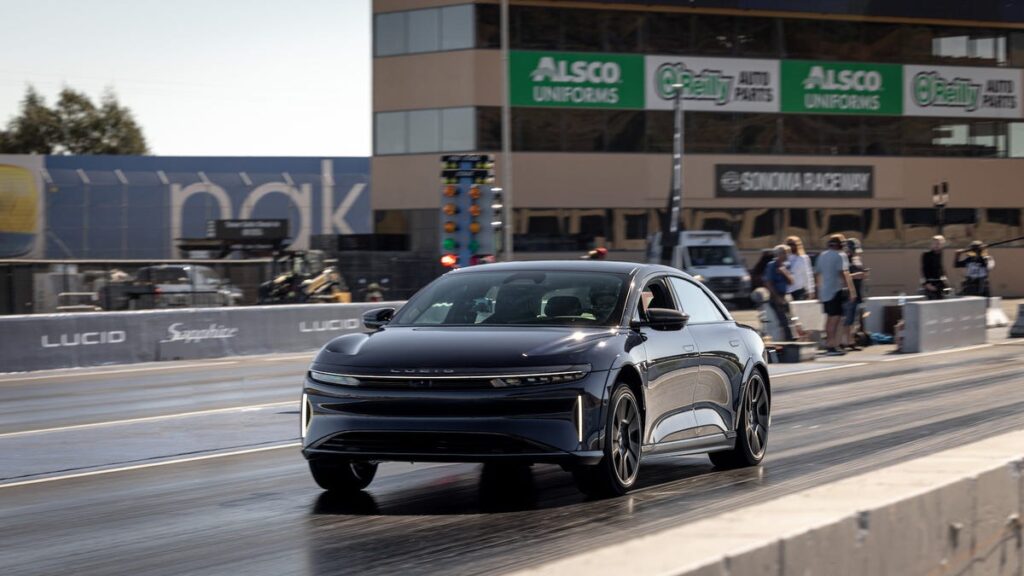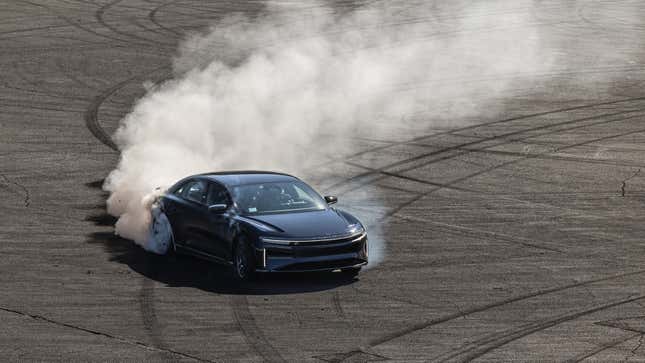The 1,234-HP Lucid Air Sapphire Almost Made Me Barf, It Ruled

Sonoma Raceway is one hell of a track. It’s got gnarly corners, iffy pavement in places, tons of elevation change and pretty much no place where you can get something wrong without paying for it. In other words, it’s serious business and that’s why I was mystified (and honestly a little terrified) to spend my time there driving Lucid’s 1,234-hp, 5,336-pound Air Sapphire.
Here Are The Best Rally Car Noises And Jumps From Lake Superior Performance Rally
If you’re not familiar with Lucid’s Air hierarchy, it goes like this: Pure RWD, Pure, Touring, Grand Touring, Grand Touring Performance and at the top is the triple-motor Sapphire. Up to this point, I’ve driven all the Air models except for the just-announced Pure RWD and the super limited Air Dream Edition (which is mostly just a GTP with a little more power and a cool paint color) and I’m really pleased to say that the things that make the Air one of my favorite cars – chassis dynamics, styling, comfort – are present at every one of those trim levels. So, that begs the question: Does the Sapphire need to exist?
The answer to that is a big no but also a little bit yes. See, the Sapphire is a wildly impressive technological achievement and fundamentally way better at getting around one of North America’s best race tracks than it should be. It can rip off repeatable 8.95-second quarter mile times (more on this later) and then hang tail doing big nasty power slides. It’s also pretty damned nice to drive on the road, too, but there are some sacrifices made to the gods of performance.
Photo: Lucid
Before we get deeper into the philosophical stuff, let’s talk about the Air Sapphire’s guts. It’s the only Air model that you can buy with a triple-motor drivetrain. The new dual-motor drive unit lives in the back and, predictably, shares a lot of its design with Lucid’s already tiny-but-very-power-dense single motor drive unit – one of which lives up front. According to the car’s engineers, the Sapphire makes more than the advertised 1,234 horsepower figure, but because we live in the dumbest timeline, that’s what they decided to publish.
The Sapphire’s battery pack is 118 kilowatt-hours which is in the ballpark of the Grand Touring Performance’s unit. The extra motor does eat into the predicted range, of course, with the Sapphire offering an EPA-estimated 421 miles compared to the GTP’s 446-mile range (with 21-inch wheels). Ultimately, you won’t notice the difference and, depending on where you live, you might see slightly better real-world range with the Sapphire thanks to one of its other key differences: no glass roof.
Yeah, the GTP has a stupid glass roof, which, in the California summer sun, will bake you and the rest of the car’s occupants like a fucking DiGiorno unless you blast the air conditioning all the time. This was easily the worst part of the GTP drive I did last year and the metal roof of the Sapphire (which also saves weight, but who cares when the car is already this heavy) eliminates that almost completely. So does the Pure trim, but that’s another kettle of fish and $180,000-ish fewer dollarinos.

Photo: Lucid
The other big change for the Sapphire is the move to some big ol’ carbon ceramic brakes. The front rotors are 16.5 inches in diameter and gripped by 10-piston monoblock calipers. The rears are 15.4 inches with four-piston calipers, but size doesn’t tell the whole story. Many carbon ceramic rotors – Porsche’s PCCBs, for example – use short, chopped carbon strands embedded in the ceramic matrix. This is fine, but as many track rats with PCCB-equipped 911s will tell you, it’s not ideal, because they can wear quickly. Lucid has partnered with a super-secret (probably Brembo or Akebono) brake company that has developed a rotor that uses continuous strand carbon which the company says makes for better heat transfer which reduces oxidation which, in turn, makes the rotors last longer. Cool, huh? Pun intended, dweebs.
Other key differences include different calibrations for suspension, accelerator pedal and steering as well as enough synthetic suede on the interior to choke a robotic cow. The Sapphire’s new sport bucket seats are supportive and well-bolstered but not as all-day comfy as the regular seats. One cool addition to the sport seats is a headrest pad that adjusts forward and back to accommodate helmet use. I hope this makes it to the standard cars, because it’s nice to have the extra support.
All these changes work in aggregate to make the Sapphire a car that acquitted itself fairly admirably on the race track. I didn’t feel like I was ever going to run out of brakes, despite braking hard and braking late(ish). The tires – bespoke Michelin Pilot Sport 4S – are the limiting factor here. This is a big, heavy and very powerful car and despite specialized tuning with Pilot Sport Cup 2 compound on the shoulder blocks, these babies are hanging on for dear life. If you’re a potential Sapphire owner, be prepared to replace them often and really, really often if you’re the kind of maniac who wants to take the car to a road course.

Photo: Lucid
EV drag racing is boring and dumb by now. Everyone does it, all EVs feel quick and blah blah. The Sapphire is a different story. This car is brutally quick (and fast) and I’m not exaggerating when I say that two quarter-mile passes in it almost made me puke and gave me a gnarly headache for the rest of the day. I’ve driven a lot of fast cars and motorcycles, but nothing has felt like this. Sonoma’s drag surface isn’t ideal, as it goes uphill and the pavement is meh, but I was doing sub-two-second 0-60 times with an ET just over nine seconds and a trap speed of 155 mph. That they will sell this thing to anyone with lots of money boggles the mind.
So, back to the philosophical stuff.
The yes part of “Does the Sapphire need to exist?” is essentially the same reason any brand builds a halo model. It’s meant to show off the best of what it can do when unfettered by things such as practicality or, to some degree, cost. This is how we get cars like the Mercedes-AMG SL65 Black Series or the Porsche 911 ST or, to address the elephant in the room, the Tesla Model S Plaid. Lucid needs to be seen as competitive with the best that Tesla can offer, even if its core offering is already better than the Model S in almost every measurable way.

Photo: Lucid
People want to know that their particular brand of car is the best brand of car and that all other brands of car are bad.
The no part of that equation is slightly simpler. With a retail price of $249,000 and all that power, nobody really needs the Sapphire. It’s not a bad car – far from it – but you will likely be just as happy driving a sub-$100,000 Air Pure as you would be driving the baddest Air around. EVs should be getting more affordable, with way less focus on super long estimated ranges or batshit performance. The Sapphire is anathema to all that, but it sure is a good time.



